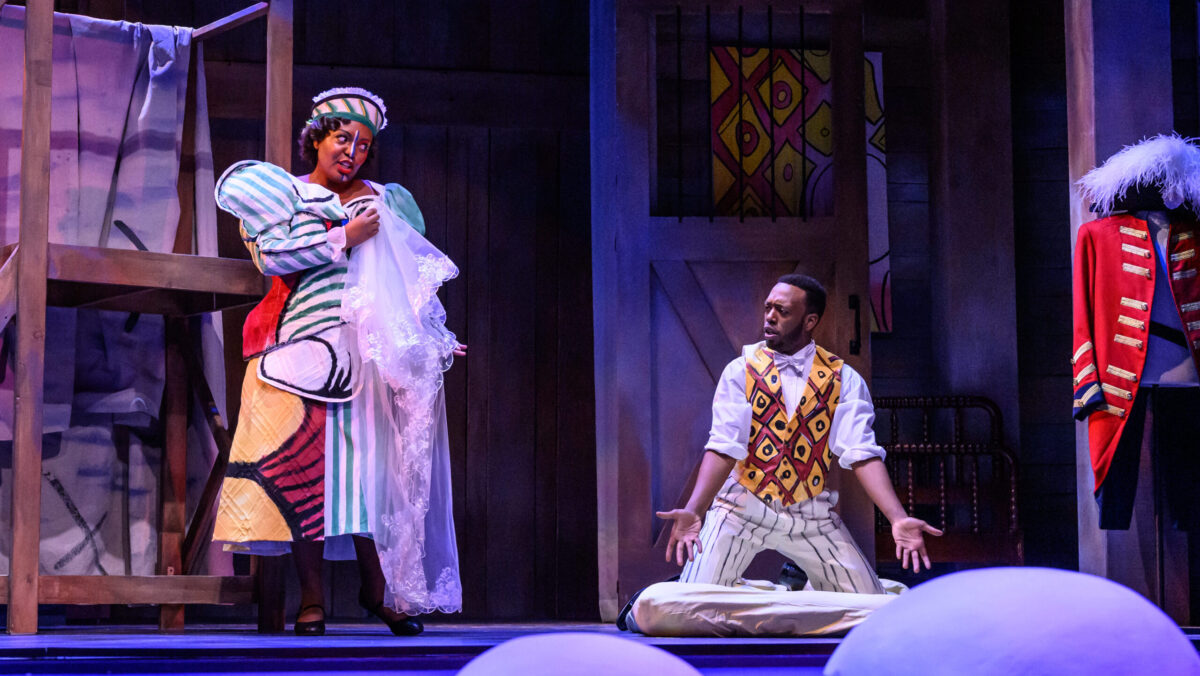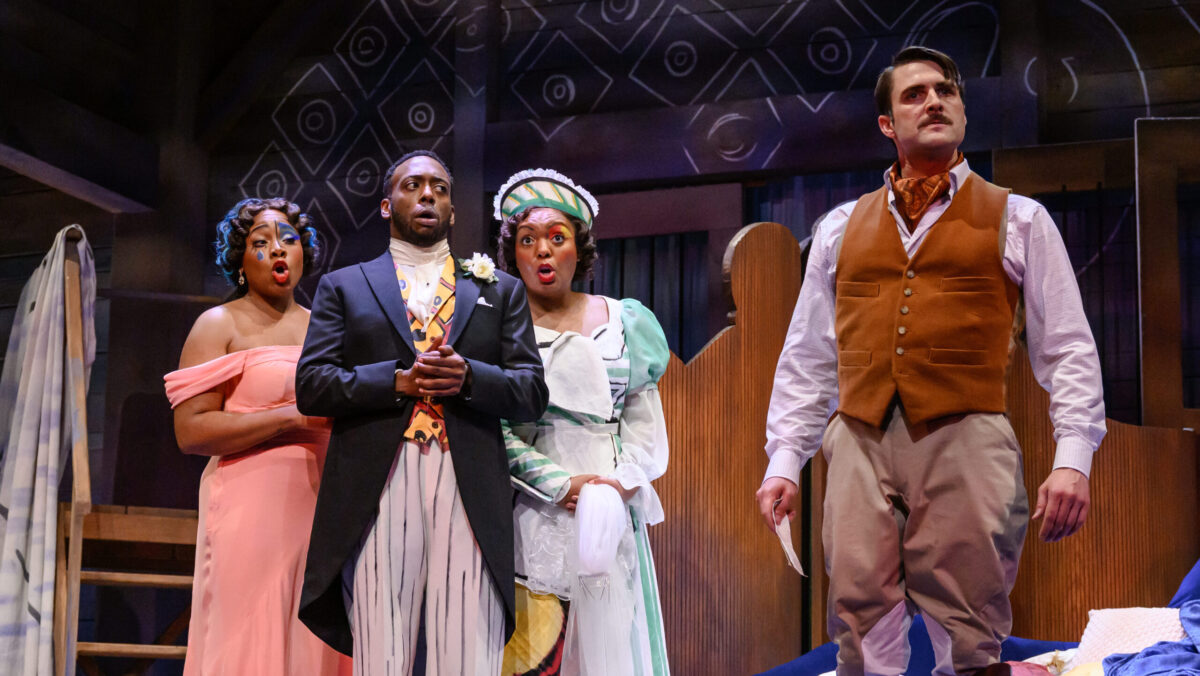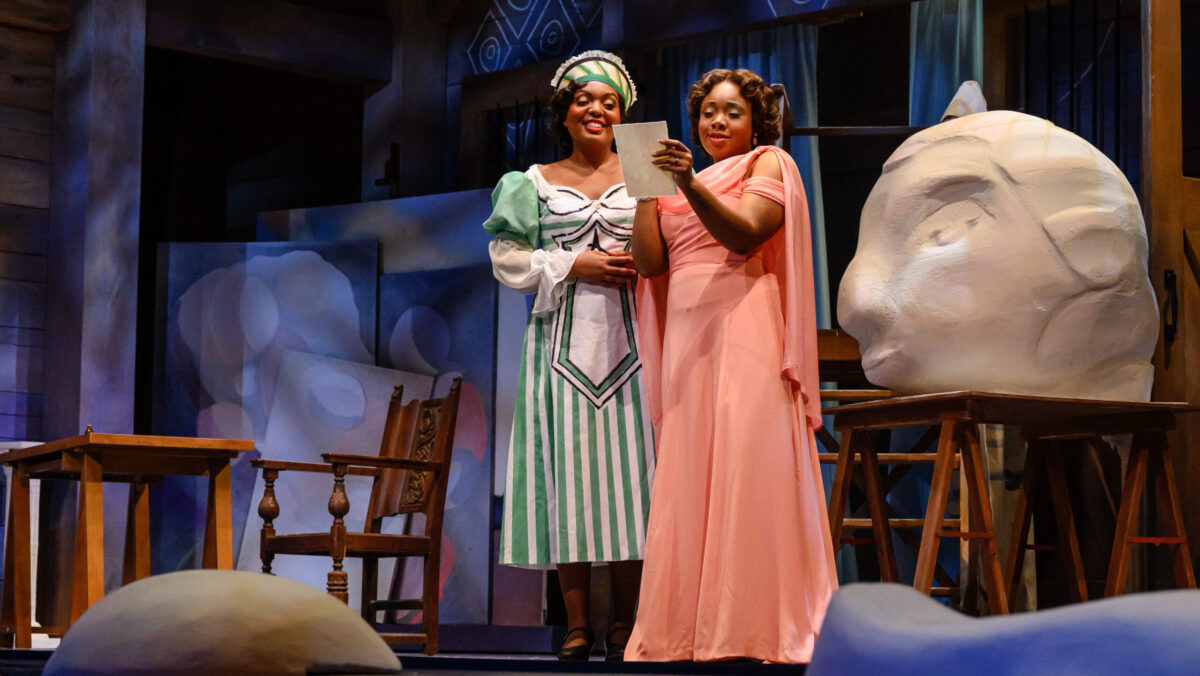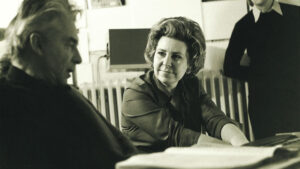
Rich Kessler, courtesy of Wolf Trap
Directed by E. Loren Meeker, Wolf Trap’s production of Nozze shifted the action from Count Almaviva’s estate to an artist’s studio suggestive of Picasso. Meeker depicted the count as a bully in the mold of the Spanish artist, who was notorious for mistreatment of women throughout his life. Her effective framing thoughtfully raised questions about gender, power dynamics, and abusive behavior in the arts in the wake of the #MeToo movement while preserving the humor integral to Mozart and librettist Lorenzo da Ponte’s opera buffa. Meeker retained the elements of farce traditional to Nozze and there were plenty of slamming doors, characters hiding around corners, and other gags to entertain the audience while also addressing the more serious topics.
In an interesting commentary on the role of women as muses for the male gaze in Western art history, the creative team dressed the leading women in attire and makeup reminiscent of a Cubist painting, which Susanna shed over the course of the first two Acts as she reclaimed her agency. Loren Shaw designed the strikingly original costumes, some of which also took inspiration from Picasso’s harlequin paintings. Painstakingly detailed makeup by Anne Nesmith completed the Cubist aesthetic.
Sculptures, including the archetypical bull, and Cubist-style paintings on easels lent Laura Fine Hawkes’s scenery an authentically Picasso-esque air, though modernist geometric paintings on the walls bore little resemblance to his style. The wooden walls of Hawkes’s set blended into the rustic interior of the Wolf Trap’s Barns, giving the audience an immersive experience. Wolf Trap Opera’s performances feature talent from the company’s Filene Artists program of up-and-coming singers and Studio Artists program of students and recent graduates. Wolf Trap alumni include such well-known stars as tenor Lawrence Brownlee and sopranos Erin Morley and Christine Goerke.

Rich Kessler, courtesy of Wolf Trap
Christian Simmons’s agile, warm bass-baritone made him a strong Figaro, and he sounded especially authoritative in his lower register. An alumnus of Washington National Opera’s Cafritz Young Artists program, Simmons notably stood out in Figaro’s Act IV recitative and aria “Tutto è disposto” and “Aprite un po’ quegli occhi” and shared a healthy dose of glee in the character’s more humorous moments.
As Figaro’s fiancée Susanna, Arianna Rodriguez boasted an expressive stage presence. Her sunny soprano and graceful phrasing made her a natural fit for the role, which is at the heart of the scheming that contributes so much to Nozze’s comedy. She sounded particularly fine in the character’s Act IV aria, “Deh vieni non tardar” and paired well with Simmons in the opera’s finale.
Baritone Charles H. Eaton took on one of the more challenging assignments of this staging of Nozze: Count Almaviva. In this role, Eaton had to be threatening enough to be taken seriously as a bully and harasser, yet funny enough to land Nozze’s humor. He delivered on both scores and his clear, suave baritone made him a highly believable count.

Rich Kessler, courtesy of Wolf Trap
Returning to Wolf Trap Opera after stints as a Studio Artist (2021) and Filene Artist (2022), soprano Brittany Olivia Logan brought a powerful, big voice to the Countess and shone in her emotional take on the character’s Act III aria “Dove sono.” Rounding out the principal cast, mezzo-soprano Sophia Maekawa sang Cherubino with charmingly melodramatic humor and lent her silky mezzo to moving renditions of “Non so più” and “Voi che sapete.”
An opera diva in the making, mezzo-soprano Elissa Pfaender excelled as Marcellina. Pfaender’s impeccable comedic instincts made her a delight on stage and Wolf Trap operagoers will be fortunate to have the opportunity to see her in a principal role as Carmen at the Filene Center on 15 August. As her co-conspirator and eventual husband, bass-baritone Sam Dhobhany was a solid Bartolo, a role that leveraged his impressive lower register.
Under the baton of conductor Emily Senturia, Wolf Trap Opera’s orchestra delivered a fine presentation of Mozart’s score, overcoming challenges including the smaller size of the ensemble and the orchestra’s occluded position under the Barns stage. Kiril Kuzmin effectively directed the chorus, composed of Wolf Trap Opera Studio Artists. The company’s season continues with a production of Francis Poulenc’s Dialogues of the Carmelites later this month.




Comments